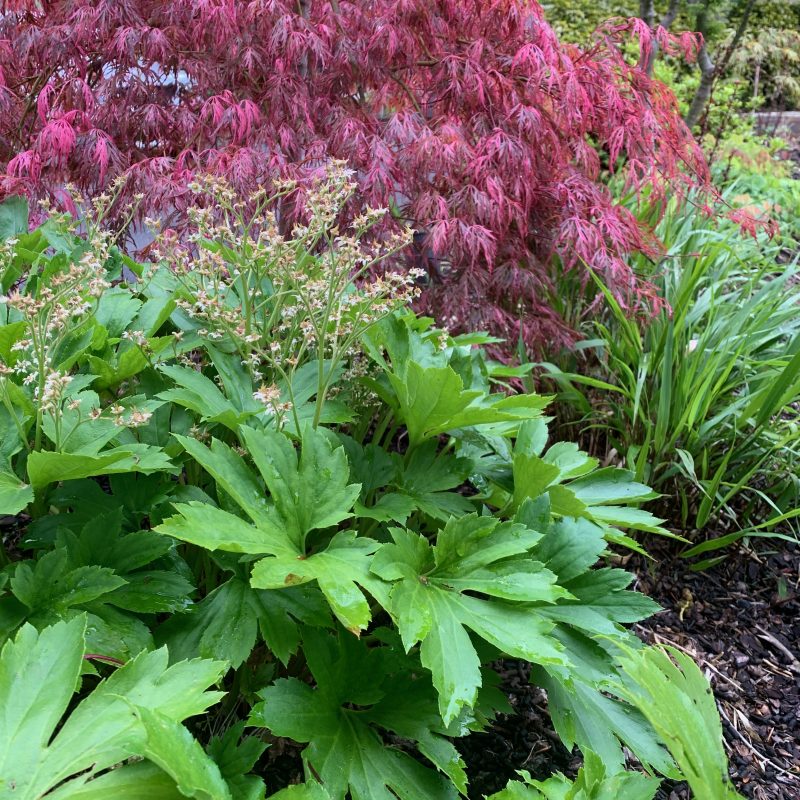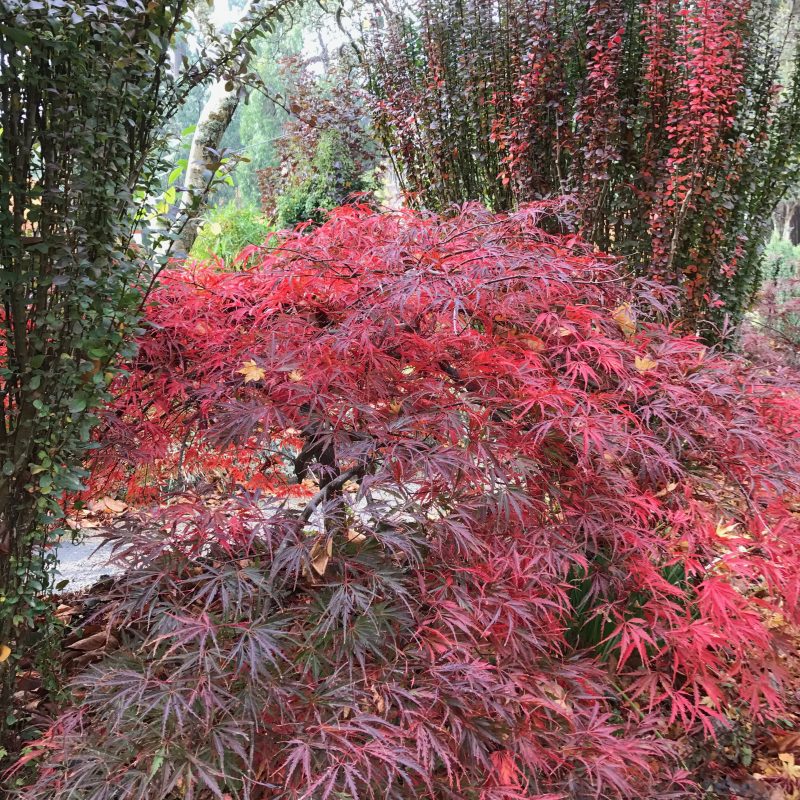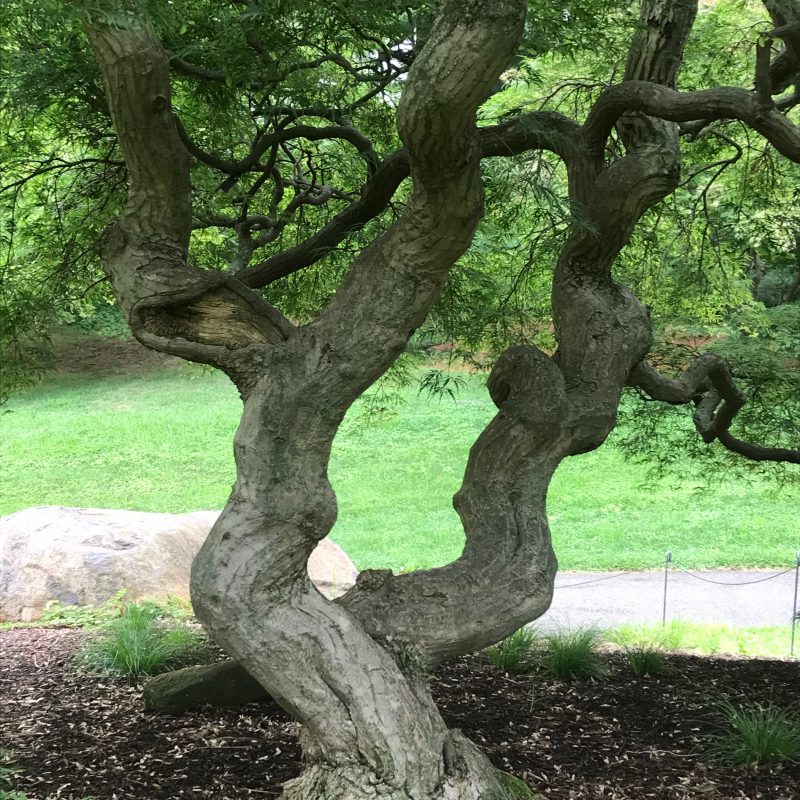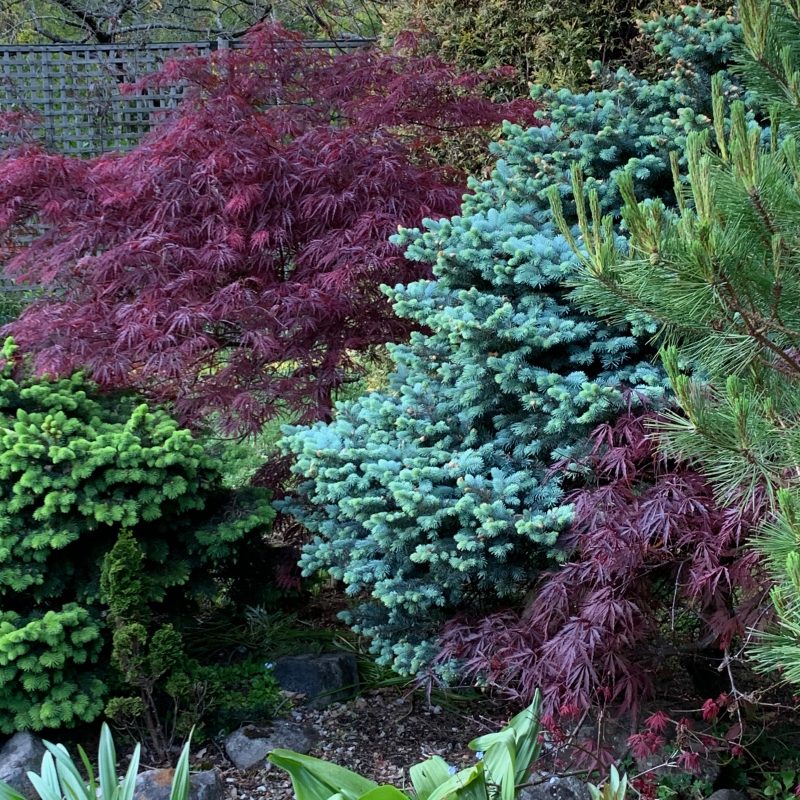Uncategorized
HOW AND WHERE TO GROW WEEPING MAPLES
What is a weeping maple
Weeping maples fall within the genus of Acer and their species is palmatum, this is the species name for Japanese maples.
Japanese maples are divided into a number of groups, upright trees, upright dwarf and disectum (weeping). In this post I will concentrate on weeping maples because they are the most popular form. All the disectums are of garden origin meaning they do not occur in the wild.

Disectum maples are all grafted on to seedling raised Acer palmatum. There are two reasons for this, firstly they are not strong on their own roots and secondly they are weeping shrubs so they mound rather than grow upwards. Disectum maples will grow up a little but the habit of their branches is to weep. It is important when buying these plants to remember this and select a plant roughly the height you want.
WEEPING MAPLE CHARACTERISTICS
The name disectum is given because of the finely dissected leaves for which these plants are so revered. Weeping maples have branching which generally grows outwards and downwards unlike a conventional deciduous tree whose branches sweep upwards and then weep on the tips. A weeping maple is going to have a greater spread than height. They will grow upwards slowly and with a mounding habit. Large old specimens may reach 3 metres but this happens over a very long time period.

These are deciduous shrubs meaning the leaves fall in Autumn and the plant is bare over winter. Anyone who is familiar with these plants will understand their exquisite appearance when bare when the true structure of the plant is revealed. During the summer months they generally appear as a mound of foliage albeit a beautiful mound.
The foliage colour is dependant on the cultivar but roughly they are either burgundy or green with many shades in between. The leaf structure also varies, some finely dissected others more chunky. Those with very finely dissected leaves are prone to leaf scorch in hot weather and are often very slow growing.
These are mostly slow growing plants and are often sold as advanced shrubs because of this. Advanced plants can be expensive because of the many years they take to produce.

Autumn colour is dependent on variety and the conditions it is growing in.
For deciduous trees to colour well in Autumn requires cool and dry conditions. This is why the Autumn colour experienced in Canberra or Bright is so superior to Melbourne. Autumn colour here in the Dandenong ranges varies from season to season . My view is to select a cultivar for its structure and summer leaf colour because Autumn colour is very fleeting and not a given.
DISECTUM MAPLE VARIETIES
The range of cultivars in this group of maples is vast and growing. I am very far from an expert on maple cultivars so will restrict my comments to a very few.
Each cultivar has different characteristics in leaf colour and shape or in growth habit. Some of the red leaf forms carry that colour all Summer others slowly change to green as the season progresses. There are forms selected only for their spring foliage which can be astounding hana matoi for example has hot pink emerging foliage whereas atropururea’s new foliage is red and appears to be dusted with silver.

The variations in form allow selection on the basis of available space. Orangeola and waterfall both have a sharply weeping habit which makes them perfect for a confined position whereas vics pink hardly weeps at all but tends to spread outwards so needs room to do that.

For Autumn colour my top pick would be red dragon, this cultivar holds its red leaves most of the summer then in Autumn they slowly transform to a rich scarlet red. Orangeola has red new foliage in spring which fades to a rusty red then green over summer, in Autumn it turns deep red. Green filigree has finely dissected green foliage that turns deep red and orange in Autumn, this is one of the last cultivars to colour up here.

vics pink has foliage that’s pink in spring green over summer then a rich red in autumn, this cultivar is rarely seen in the nurseries it’s one of my absolute favourites for vigour, form and foliage.
As stated above Orangeola and waterfall both weep sharply so they form a narrow dome and require some pruning at ground level but are both are good cultivars for a confined space. Green filigree is very vigorous sending out long whippy growth all summer some of which is best shortened, this variety needs some pruning particularly when young. Tamukeyama is a very good red cultivar whose growth is both outwards and pendulous, it makes a large shrub in time and has great red Autumn colour. Viridis is a good green variety that has a wide spreading habit and orange Autumn colour. Hana matoi is very condensed, twiggy and slow growing. Inaba shidare is an old Japanese cultivar said to be the best red leaf. It has wide branches which extend out horizontally then weep on the tips meaning its also a wide spreading shrub.

POSITIONING WEEPING MAPLES
One of the fundamental skills of gardening is the knowledge to select the correct position for each plant species. To decide the position of a plant based solely on your aesthetic often invites failure. Never try to force you’re will on plants, if a plant is incorrectly placed no amount of attention is going to make it happy. The plant may survive but will rarely look its best.
Disectum maples require shelter. If exposed to hot sun and more importantly wind the leaves will brown on their margins early in the summer and they will retain those leaves all season. Cool climate gardeners can place maples in full sun provided they are sheltered from strong wind. In parts that experience intense heat and hot north winds a sheltered easterly aspect is best. Full sun up to midday is good, hot afternoon sun problematic. For the diligent gardener a large square of shade cloth thrown over them in extreme heat helps. Fluctuation in soil temperatures can influence a maples health and therefore appearance. In late Summer early Autumn soil temperatures rise. Maples like a cool root run.

Soil temperatures can be controlled in a couple of ways. The simplest is a mulch of wood chip at least 15cm deep and applied annually, this has the added benefit of soil improvement. Large rocks placed over the root ball with one third of the stone buried also provides good soil insulation. Rock used in conjunction with mulch is a very good option.
Maples are often recommended for shade but in my experience they perform best with good morning sun. Planted in too much shade their foliage can be sparse and leaf colour insipid. Perhaps a high canopy of deciduous dappled shade could work but certainly not full shade.
Disectum maples do not generally thrive as lawn specimens in Australian gardens unless the site is very sheltered. If planted in lawn they must be given a good sized garden bed and never grown with lawn up to the trunk.

Planting and ongoing care
Soil preparation really helps any plant settle into the garden quickly. To just dig a hole and plant your maple in unworked garden soil is to deny the plant its best start.
Dig a hole three times the size of the pot and work in plenty of humus. The humus can be aged animal manure (not poultry), compost, decomposing wood chip or any combination of those three. I also add some organic fertiliser and dolomite and work into the soil well.
Always water newly planted trees then apply a thick layer of mulch.
Autumn is the best planting season while the soil is still warm. The trees may appear to be going into dormancy at this time but their roots will still be growing strongly so the tree will have maximum chance to settle in before the late summer dry.
Spring is probably the worst time to plant. In spring the soil is at its coldest and the trees have been sitting in warm plastic pots, their roots are not growing strongly and won’t do until the sol warms again.
Young plants are prone to leaf scorch over summer and can look very tatty, this may continue for 2-3 years. Once the trees are well established the leaf scorch should stop.
Aphids in spring can be an issue with these plants. When the trees are young the impact of aphids can be detrimental. However the big old maples in my garden can have heavy aphid infestations and I do nothing bout them. The first crop of leaves may be impacted but later in the spring and into early summer the aphids have finished and the trees will develop new healthy leaves.
I am not an advocate of insecticides as their reach is always far greater than just the target pest. For young maples manual removal can be viable but may need to be repeated a few times during the aphid season.
How to feed maples
A well fed tree has lustre, its leaves are large and their colour more vibrant.
Autumn is a good time to fertilise maples, at this time the tree is developing buds for next springs leaf growth and its roots are growing strongly. The fertiliser will help more prolific bud development meaning the tree will have a dense canopy of foliage the following season.
Feeding is best done in conjunction with mulching. Fertiliser is evenly spread beneath and just beyond and beneaththe trees canopy. Mulch should be spread on top of the fertiliser.
The amount of fertiliser is dependent on the plants age. A mature maple can be given 5kg or more. Younger trees 1-2kg.
If you have never fed your Maple give it a big feed and watch its appearance transform.https:/gentiananursery.com.au/wp-admin/post.php

Do weeping maples need to be pruned ?
The short answer is yes and I will explain why and how.

Weeping maples are an aberration.
They do not and would not survive in the wild.
Their growth habit can be congested and unruly.
Some people just skirt them, keeping the canopy all the same height so the tree ends up looking like an umbrella usually with a giant tangle in the centre.
An unpruned Disectum will have an understory full of dead wood, its branching will be all over the place with lots or branches crossing from one side of the canopy to the other, and the tips so dense they hold the autumn leaves in big brown clumps all over the tree.
When production nurseries grow maples their goal is to get the head as full as possible as quickly as possible. I can understand the haste, these plants take years to produce. Grown quickly many of these plants will have branches crossing right through the canopy possibly in many places. As the tree ages these misplaced branches will become more obvious. Selective pruning should be done while the plant is young. Maples will back bud easily so don’t be afraid of cutting them. Old plants can be rejuvenated with heavy pruning however small amounts annually is the preferred treatment.
I made a video on Maple pruning with my friend John. Here is the Youtube link
linkhttps://www.youtube.com/watch?v=nuY-z6uP1OM
Companion plants for Weeping Maples
In my garden the disectum maples are planted to provide me with the perfect habitat for late winter early spring flowering woodland bulbs, Eranthis, Cyclamen, Galanthus, crocus etc. The positioning of these plants beneath deciduous shrubs provides them with the perfect growing conditions, winter sun and summer cool. This planting also means that these bulbs can be enjoyed while the trees are bare. Other plants would serve as perfect ground covers under maples would be dwarf Mondo, Geranium macrorrhizum, Symphytum uplandicum, Epimedium spp mainly the low spreading forms or Ajuga pink elf.
Acer and dwarf conifer are very well suited to each other, Picea pungens montgomery with its intense silver foliage is stunning with one of the red leaf forms such as Tamukeyama.
Low grafted maples sit well with large leaf perennials such as Bergenia, Mukdenia, Farfugium or Rodgersia. Their big leaves will highlight the finely dissected maple foliage.
Grasses also sit nicely with maples although they must be an appropriate size. Some options are Panicum heavy metal, again going for that red and grey combination. In a sheltered semi shaded position the green Japanese forest grass Hakonechloa macra is perfect
The Aucuba called rosannie makes a great background shrub, again that combination of big shiny leaves with fine foliage. A similar effect can be achieved with Fastsia japonica or and of the Mahonia (now Berberis) species.

Hi,
I have a 15yr orangeola maple tree.
Thinking of putting into a bonsai, can I cut though the trunk to shorten.
If so, when would be the best time.
Thankyou, loved the write up.
Hi Glen, All the disectum maples are grafted usually on to Acer palmatum seedlings. This means that if you cut below the graft then you will not have orangeola any more, your plant will be a normal Japanese maple.